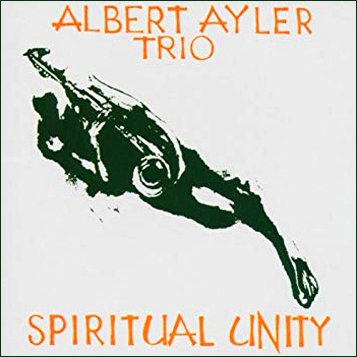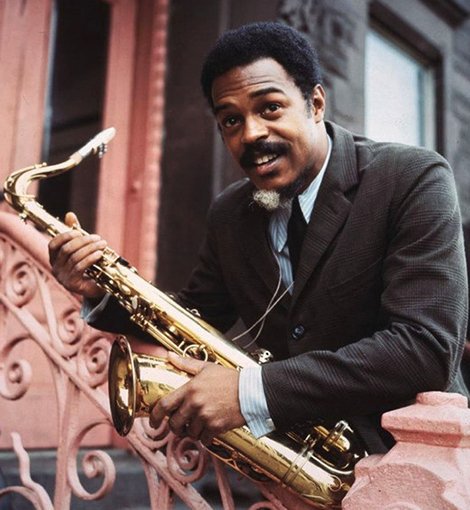Ghosts: First Variation
Albert Ayler (saxo tenor), Gary Peacock (contrabajo) y Sunny Murray (percusión). Extraído del álbum Spiritual Unity (1965).
Este álbum empujó al saxofonista tenor Albert Ayler a la primera línea de la vanguardia del jazz y llamó la atención internacional. Es el proyecto con mayor cohesión de conjunto emprendido hasta ese momento por el compositor, revolucionando la concepción de lo que es posible interpretar con un saxo tenor, un contrabajo y una batería. Todos los miembros escuchan los detalles más sutiles de la interpretación de los demás, animando y respondiendo cuando es apropiado, y su improvisación colectiva está sorprendentemente unificada. El trío no esconde nada y toca como si sus vidas dependieran de ello. Ayler demostró que su drástica reelaboración del vocabulario del saxofón de jazz era autosuficiente y no necesitaba otros instrumentos de viento para apoyar su virulento ataque. Este abarcaba exploraciones de los armónicos y evocaciones del sonido de cuerda en el registro superior.
This album pushed tenor saxofonist Albert Ayler to the forefront of the jazz avant-garde and attracted international attention. It’s the project with the greatest group cohesion initiated up to that time by the composer, revolutionizing the concept of what is possible to perform with a tenor saxophone, a double bass and drums. All members listen to the subtler details of each other’s performance, encouraging and responding when appropriate, and their collective improvisation is surprisingly unified. The trio hold nothing back, playing as if their very lives depended on it. Ayler showed that his drastic reworking of the jazz saxophone vocabulary was self-sufficient and didn’t need other wind instruments to support his fierce attack. This included explorations of the harmonics and evocations of the string sound in the upper register.

Sus gritos, chillidos, lamentos y el vibrato más amplio jamás escuchado en un álbum de jazz eran expresiones sonoras de un intenso anhelo de trascendencia. Las notas que surgen de su instrumento desaparecen sopladas por el viento llenas de furia, y aunque esta furia es aterradora, está absolutamente contenida. Parece que Ayler nunca escucha una sola nota a la vez y habla a una conciencia expandida. Su música es la manifestación física de un ritual místico y su lógica es la de la carne humana en la esfera del espíritu. Además, las ideas que fluyen libremente del contrabajo de Gary Peacock y los ritmos cambiantes del batería Sunny Murray son cruciales para eliminar las limitaciones interpretativas de Ayler. Con melodías cantables basadas en canciones folclóricas tradicionales y escalas estándar, Ayler toma las formas musicales más simples y las impregna de un poder visceral impactante.
His yellings, shrieks, laments and the broadest vibrato ever heard on a jazz album were sound expressions of an intense desire for transcendence. The notes that emerge from his instrument disappear blown by the wind full of fury, and although this fury is terrifying, it’s absolutely contained. Ayler never seems to hear a single note at a time and speaks to an expanded consciousness. His music is the physical manifestation of a mystical ritual and his logic is that of human flesh in the sphere of the spirit. Also, the ideas that flow freely from Gary Peacock’s double bass and the changing rhythms of drummer Sunny Murray are essential in removing Ayler’s interpretative limitations. With cantable melodies based on traditional folk songs and standard scales, Ayler uses the simplest musical expressions and infuses them with a striking visceral power.

Ayler hace una corta introducción y luego Peacock y Murray se incorporan para exponer el tema, que parece una canción infantil. Sin embargo, en cuanto acaba, cualquier sentido de la armonía, melodía o ritmo desaparecen y cada miembro del trío toca libremente. Aunque se trata de una improvisación colectiva, Ayler destaca por producir sonidos insólitos con su saxofón. A continuación, Peacock hace un solo con una línea melódica espontánea, pero coherente dentro de su particularidad hasta que vuelve Ayler para reexponer el tema.
Ayler makes a short introduction and then Peacock and Murray join in to expose the theme, which seems like a children’s song. However, as soon as it ends, any sense of harmony, melody or rhythm disappear and each member of the trio plays freely. Although it’s a collective improvisation, Ayler stands out for producing unusual sounds with his saxophone. Next, Peacock makes a solo with a spontaneous melodic line, but coherent within its peculiarity until Ayler returns to restate the theme.

Translated with the help of DeepL

The Wizard
Albert Ayler (saxo tenor), Gary Peacock (contrabajo) y Sunny Murray (percusión). Extraído del álbum Spiritual Unity (1965).
En este tema Ayler repite una frase tres veces y enseguida comienza a hacer su solo de forma desmedida. Su discurso no está limitado por nada y se suelta por completo dando la sensación de proceder de otro planeta. En él introduce sonidos extremos que surgen de su saxofón nunca oídos anteriormente mientras Peacock y Murray se aferran a su interpretación como un vaquero lo haría a un novillo en un rodeo. A continuación entra Peacock desplegando (displaying) una línea melódica desprovista de cualquier frase convencional y tocando de forma aleatoria. Después vuelve Ayler para reexponer el tema.
In this theme Ayler repeats a phrase three times and immediately starts to make his solo in an outrageous way. His speech is not limited by anything and he is released completely giving the feeling of coming from another planet. He also introduces extreme sounds that arise from his saxophone never heard before while Peacock and Murray cling to his interpretation as a cowboy would a steer in a rodeo. Then Peacock enters displaying a melodic line devoid of any conventional phrase and playing randomly. After that, Ayler comes back to re-expose the theme.

℗ ESP-Disk

